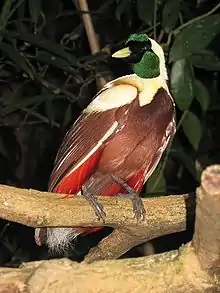| Paradisaea | |
|---|---|
 | |
| Raggiana bird-of-paradise (Paradisaea raggiana) | |
| Scientific classification | |
| Domain: | Eukaryota |
| Kingdom: | Animalia |
| Phylum: | Chordata |
| Class: | Aves |
| Order: | Passeriformes |
| Family: | Paradisaeidae |
| Genus: | Paradisaea Linnaeus, 1758 |
| Type species | |
| Paradisaea apoda (greater bird-of-paradise) Linnaeus, 1758 | |
| Synonyms | |
| |
The genus Paradisaea consists of six species of birds-of-paradise (family Paradisaeidae). The genus is found on the island of New Guinea as well as the nearby islands groups of the Aru Islands, D'Entrecasteaux Islands and Raja Ampat Islands. The species inhabit a range of forest types from sea level to mid-montane forests. Several species have highly restricted distributions, and all species have disjunct distributions.[2] A 2009 study examining the mitochondrial DNA of the family found that the Paradisaea birds-of-paradise were in a clade with the genus Cicinnurus. It showed that the blue bird-of-paradise was a sister taxon to all the other species in this genus.[3]
All are large, and sexually dimorphic. The plumage of the males includes characteristic grossly elongated flank plumes (which emerge from beneath the wings and strictly speaking are flank plumes pectoral plumes), and a pair of wire-like feathers emerging from the end of the tail. The flank plumes are used during breeding displays.[2]
The name, Paradisaea, is the Latinized form of "paradise". The local name in Indonesia is cenderawasih.
Taxonomy
The genus Paradisaea was introduced by the Swedish naturalist Carl Linnaeus in 1758 in the tenth edition of his Systema Naturae.[4][lower-alpha 1] The genus name is from Late Latin paradisus meaning "paradise".[6] The type species was designated as the greater bird-of-paradise (Paradisaea apoda) by George Robert Gray in 1840.[7][8]
Species
The genus contains six species.[9]
| Image | Common name | Scientific name | Distribution |
|---|---|---|---|
 |
Greater bird-of-paradise | Paradisaea apoda | Southwestern and southern New Guinea, as well as the Aru Islands; found at altitudes around 900–950 m. |
 |
Raggiana bird-of-paradise | Paradisaea raggiana | Most of South, East-Central, Eastern and Southeastern New Guinea; typically found around at 1500 m in altitude. |
 |
Lesser bird-of-paradise | Paradisaea minor | Most of Northern, Northwestern and Western New Guinea (nominate race found also on Misool and other nearby islands.), also Eastern New Guinea near the Huon region; found at altitudes from 0–1500 m. |
 |
Goldie's bird-of-paradise | Paradisaea decora | Fergusson and Normanby islands in the D’Entrecasteaux Archipelago located Southeast of New Guinea; found at lower altitudes than other Paradisaea members. |
 |
Red bird-of-paradise | Paradisaea rubra | Waigeo and Batanta islands of Raja Ampat in West Papua at altitudes of around 550–600 m. |
 |
Emperor bird-of-paradise | Paradisaea guilielmi | Mountains in the Huon Peninsula in Northeastern New Guinea; commonly found at altitudes of 1300–1500 m, though can be found lower at 400–670 m. |
Notes
- ↑ In the 10th edition of his Systema Naturae Linnaeus spelled the genus name as both Paradisea and Paradisaea.[5] In 2012 the International Commission on Zoological Nomenclature suppressed the spelling Paradisea.[1]
References
- 1 2 International Commission on Zoological Nomenclature (2012). "Paradisaea Linnaeus, 1758 and PARADISAEIDAE Swainson, 1825 (Aves): names conserved". Bulletin of Zoological Nomenclature. 69 (1): 77–78. doi:10.21805/bzn.v69i1.a5. S2CID 81167105.
- 1 2 Firth, Clifford B.; Firth, Dawn W. (2009), "Family Paradisaeidae (Birds-of-paradise)", in del Hoyo, Josep; Elliott, Andrew; Christie, David (eds.), Handbook of the Birds of the World. Volume 14, Bush-shrikes to Old World Sparrows, Barcelona: Lynx Edicions, pp. 404–459, ISBN 978-84-96553-50-7
- ↑ Irested, Martin; Jønsson, Knud A; Fjeldså, Jon; Christidis, Les and Per GP Ericson (2009). "An unexpectedly long history of sexual selection in birds-of-paradise". Evolutionary Biology. 9 (235): 235. doi:10.1186/1471-2148-9-235. PMC 2755009. PMID 19758445.
- ↑ Linnaeus, Carl (1758). Systema Naturae per regna tria naturae, secundum classes, ordines, genera, species, cum characteribus, differentiis, synonymis, locis (in Latin). Vol. 1 (10th ed.). Holmiae (Stockholm): Laurentii Salvii. p. 110.
- ↑ Linnaeus, Carl (1758). Systema Naturae (in Latin). Vol. 1 (10th ed.). Holmiae (Stockholm): Laurentii Salvii. pp. 83, 110.
- ↑ Jobling, James A. (2010). The Helm Dictionary of Scientific Bird Names. London: Christopher Helm. p. 291. ISBN 978-1-4081-2501-4.
- ↑ Gray, George Robert (1840). A List of the Genera of Birds : with an Indication of the Typical Species of Each Genus. London: R. and J.E. Taylor. p. 39.
- ↑ Mayr, Ernst; Greenway, James C. Jr, eds. (1962). Check-List of Birds of the World. Vol. 15. Cambridge, Massachusetts: Museum of Comparative Zoology. p. 199.
- ↑ Gill, Frank; Donsker, David; Rasmussen, Pamela, eds. (January 2022). "Crows, mudnesters, melampittas, Ifrit, birds-of-paradise". IOC World Bird List Version 12.1. International Ornithologists' Union. Retrieved 1 February 2022.